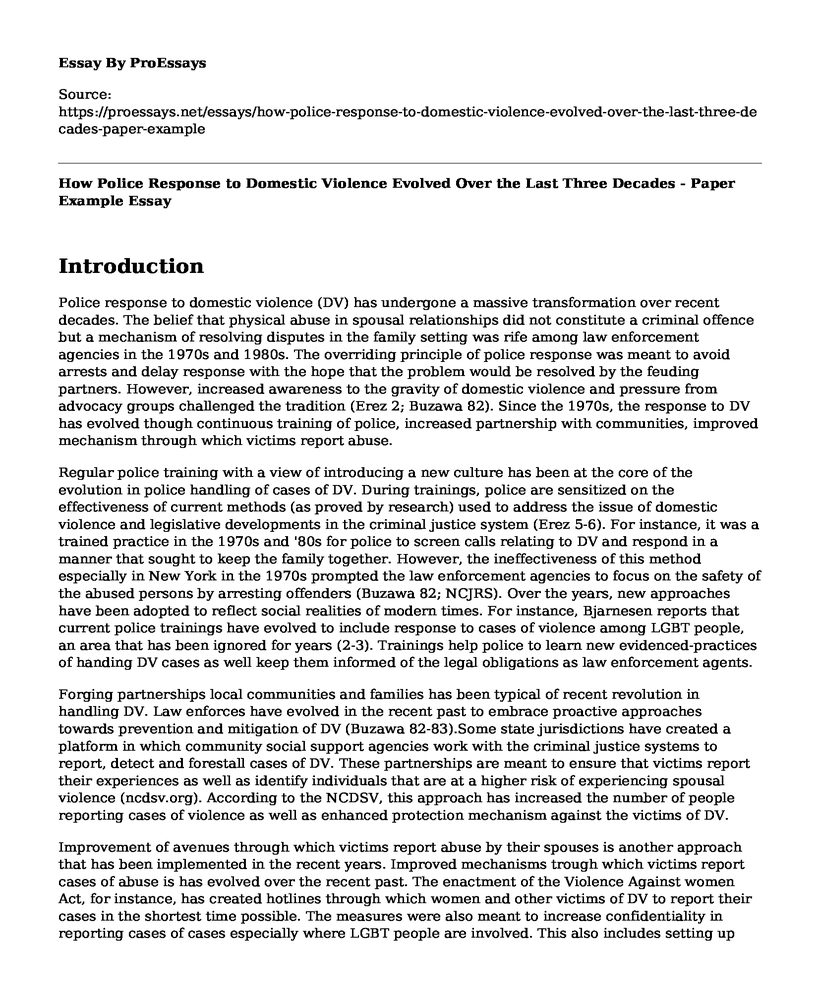Introduction
Police response to domestic violence (DV) has undergone a massive transformation over recent decades. The belief that physical abuse in spousal relationships did not constitute a criminal offence but a mechanism of resolving disputes in the family setting was rife among law enforcement agencies in the 1970s and 1980s. The overriding principle of police response was meant to avoid arrests and delay response with the hope that the problem would be resolved by the feuding partners. However, increased awareness to the gravity of domestic violence and pressure from advocacy groups challenged the tradition (Erez 2; Buzawa 82). Since the 1970s, the response to DV has evolved though continuous training of police, increased partnership with communities, improved mechanism through which victims report abuse.
Regular police training with a view of introducing a new culture has been at the core of the evolution in police handling of cases of DV. During trainings, police are sensitized on the effectiveness of current methods (as proved by research) used to address the issue of domestic violence and legislative developments in the criminal justice system (Erez 5-6). For instance, it was a trained practice in the 1970s and '80s for police to screen calls relating to DV and respond in a manner that sought to keep the family together. However, the ineffectiveness of this method especially in New York in the 1970s prompted the law enforcement agencies to focus on the safety of the abused persons by arresting offenders (Buzawa 82; NCJRS). Over the years, new approaches have been adopted to reflect social realities of modern times. For instance, Bjarnesen reports that current police trainings have evolved to include response to cases of violence among LGBT people, an area that has been ignored for years (2-3). Trainings help police to learn new evidenced-practices of handing DV cases as well keep them informed of the legal obligations as law enforcement agents.
Forging partnerships local communities and families has been typical of recent revolution in handling DV. Law enforces have evolved in the recent past to embrace proactive approaches towards prevention and mitigation of DV (Buzawa 82-83).Some state jurisdictions have created a platform in which community social support agencies work with the criminal justice systems to report, detect and forestall cases of DV. These partnerships are meant to ensure that victims report their experiences as well as identify individuals that are at a higher risk of experiencing spousal violence (ncdsv.org). According to the NCDSV, this approach has increased the number of people reporting cases of violence as well as enhanced protection mechanism against the victims of DV.
Improvement of avenues through which victims report abuse by their spouses is another approach that has been implemented in the recent years. Improved mechanisms trough which victims report cases of abuse is has evolved over the recent past. The enactment of the Violence Against women Act, for instance, has created hotlines through which women and other victims of DV to report their cases in the shortest time possible. The measures were also meant to increase confidentiality in reporting cases of cases especially where LGBT people are involved. This also includes setting up special units dealing with reports of DV.
Conclusion
As a conclusion, it can be said that police response to domestic violence has evolved over the last 30 years to reflect legal and social realities. Police response has evolved from a unit of reacting to issues of DV to an agency that is proactive. Unlike, three decades ago focus is given to the safety of victims. However, more work needs to be done police response to cases of DV among LGBT persons
Works Cited
Buzawa, Eve S. "The Evolving Police Response to Domestic Violence." Journal of Police Crisis Negotiations, vol. 12, no. 2, 2012, pp. 82-86.
Culp-Ressler, Tara. "How the Country has Changed Under the Violence Against Women Act." Thinkprogress, 2014,
Erez, Edina. "Domestic Violence and he Criminal Justice system." Online Journal of Nursing, vol. 7, no. 1, 2009, pp. 1-28.
National Center on Domestic and Sexual Violence. "Collaboration and Coalition Building/Community Organizing." 2018
Cite this page
How Police Response to Domestic Violence Evolved Over the Last Three Decades - Paper Example. (2022, Jul 04). Retrieved from https://proessays.net/essays/how-police-response-to-domestic-violence-evolved-over-the-last-three-decades-paper-example
If you are the original author of this essay and no longer wish to have it published on the ProEssays website, please click below to request its removal:
- "A Racial Crime: The Assassination of MLK" by Ayton, Mel - Critical Essay
- Leadership Style in Nigerian Essay Example
- Essay on Mainstream Media Agenda Setting Through Staged Chemical Attacks
- Migration to the US: Exploring the Legal and Illegal Routes - Essay Sample
- Essay Example on Residential Treatment Centers (RTCs): Evolution of Care for the Mentally Ill
- Paper Example on Vaping: A Growing Risk for Students?
- Free Research Paper Sample on Advanced Driver Assistance Systems







